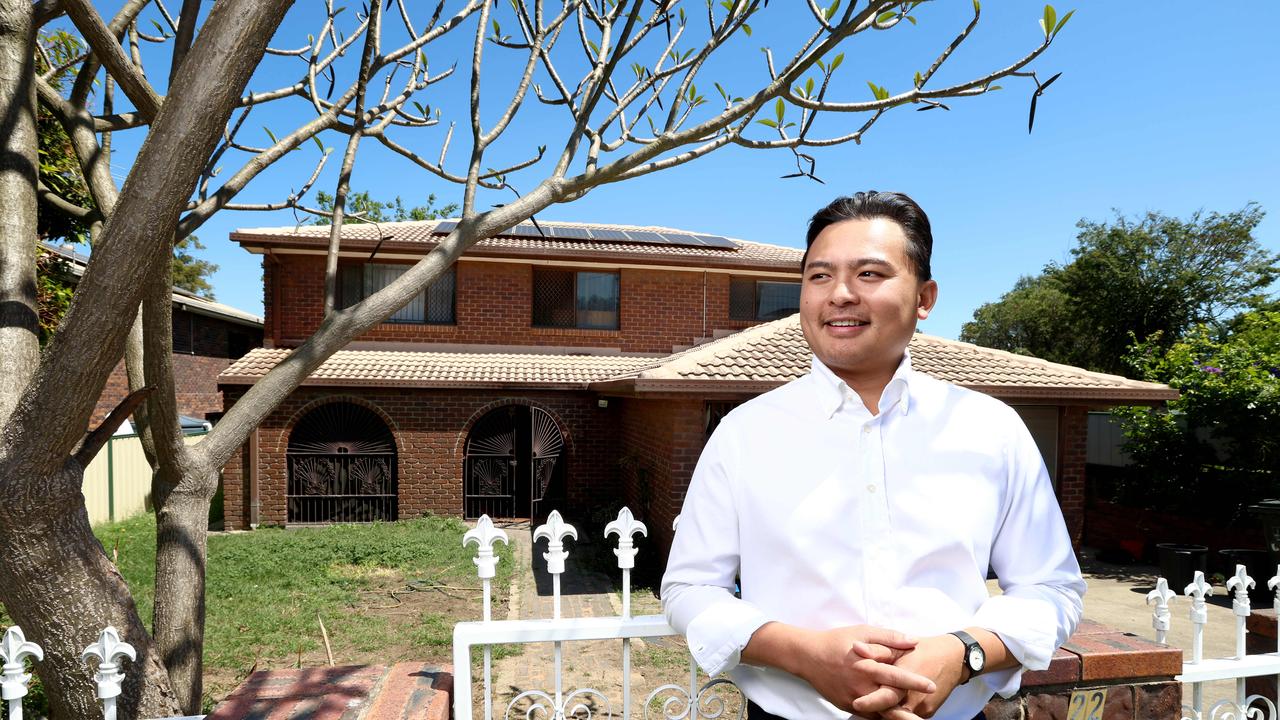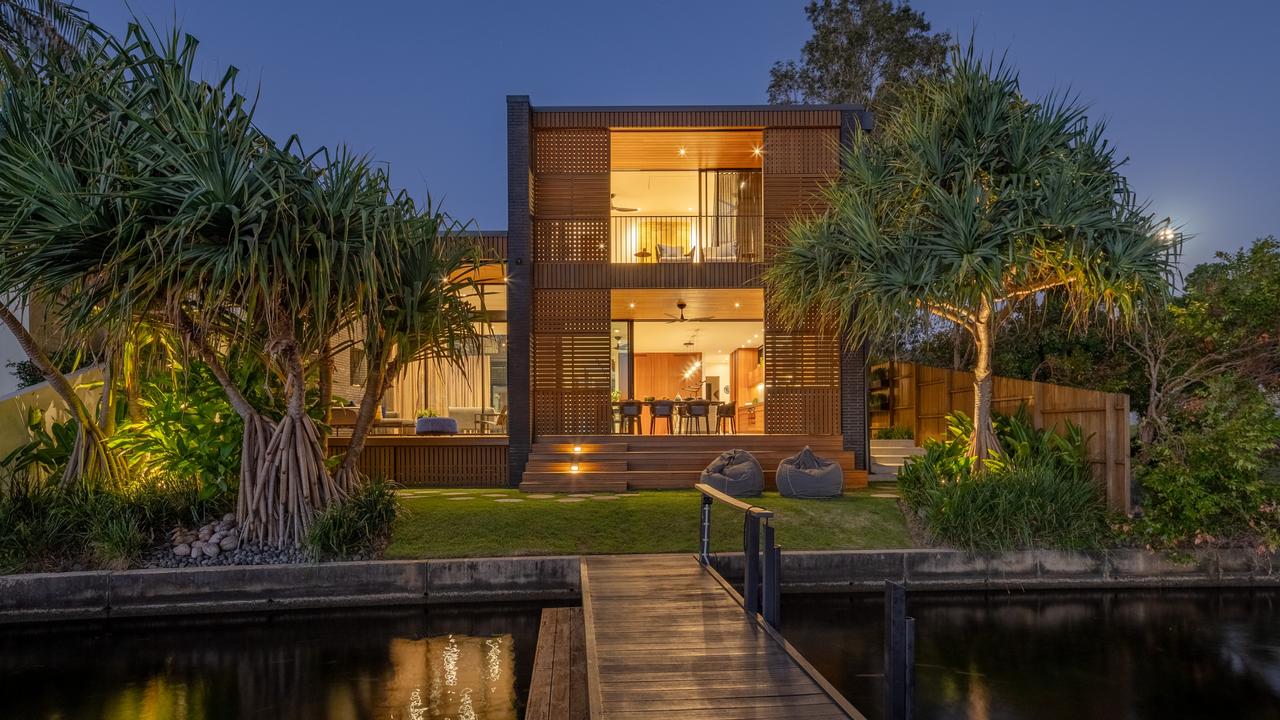Shock amount Australia’s weirdest Big Things are worth
They range from giant fruit to statues with concrete genitals, but Australia’s so-called Big Things have rich stories behind them and are often worth more than you’d think.
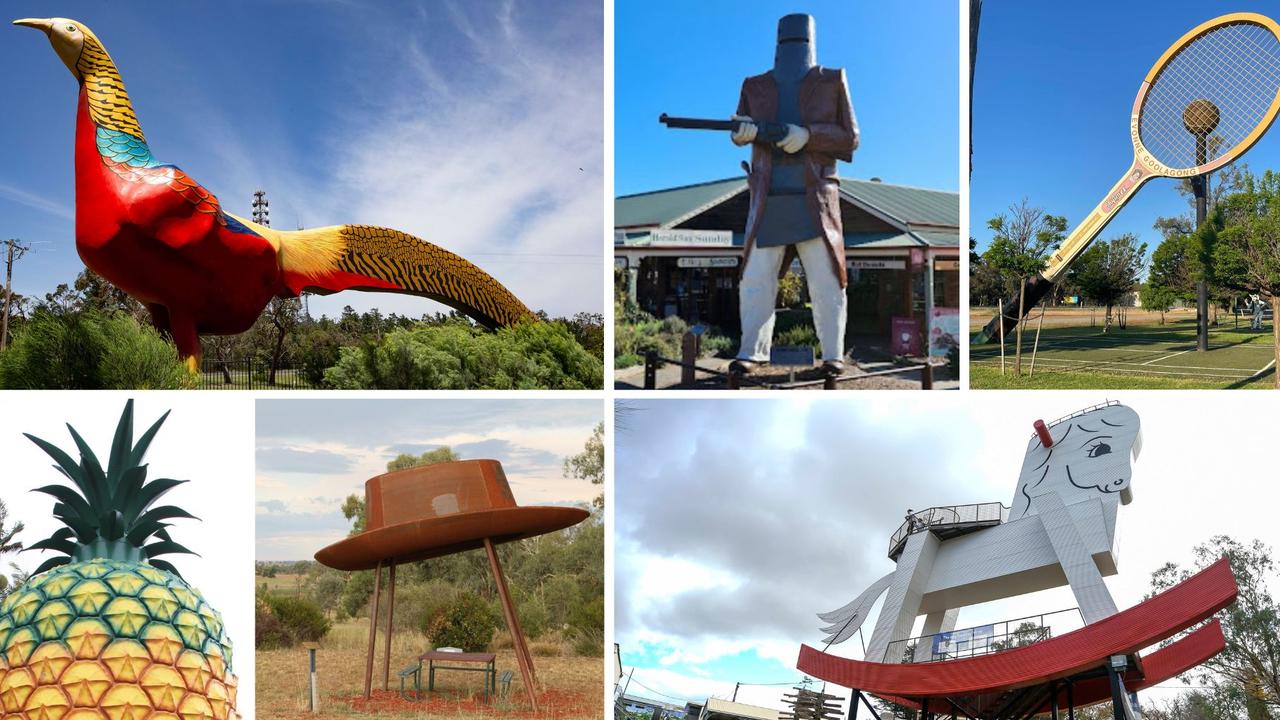
They range from famous landmarks to cheesy eyesores but Australia’s so-called Big Things have a deep and storied history – and some are worth more than you might think.
A review of recent sales transactions of properties with so-called Big Things, often fibreglass and concrete structures aimed at attracting visitors, revealed some have changed hands for millions.
There’s also just as many that have been ascribed no measurable value, becoming a frequent target for vandals, thieves and businesses seeking publicity.
One was even the target of a bomb attack that blew off half the structure.
Kevin Brogan, a valuations expert at Heron Todd White, said determining what many of these giant icons were worth was “tricky”.
“You have to measure the amount of upkeep required and how that compares to the revenue it generates,” he said.
“A question anyone building these has to ask is ‘how many visitors will it bring and is it worth the cost?’”
Whether it’s inspiration for the next road trip or something to add to the bucket list, here are some of the most iconic Big Things across each state, the stories behind them and what they’ve meant to their communities:
QUEENSLAND
THE BIG PINEAPPLE – NAMBOUR
The biggest of Australia’s ‘Big Things’ — Queensland’s Big Pineapple — was officially relaunched earlier this year.
Standing 16m high, the tourism landmark first opened in 1971 in Nambour on the Sunshine Coast, and included a tourist train, a zoo and a souvenir shop.
In 1983, it made international headlines when the late Diana, Princess of Wales and then Prince Charles took a ride on the train during their visit to Australia.
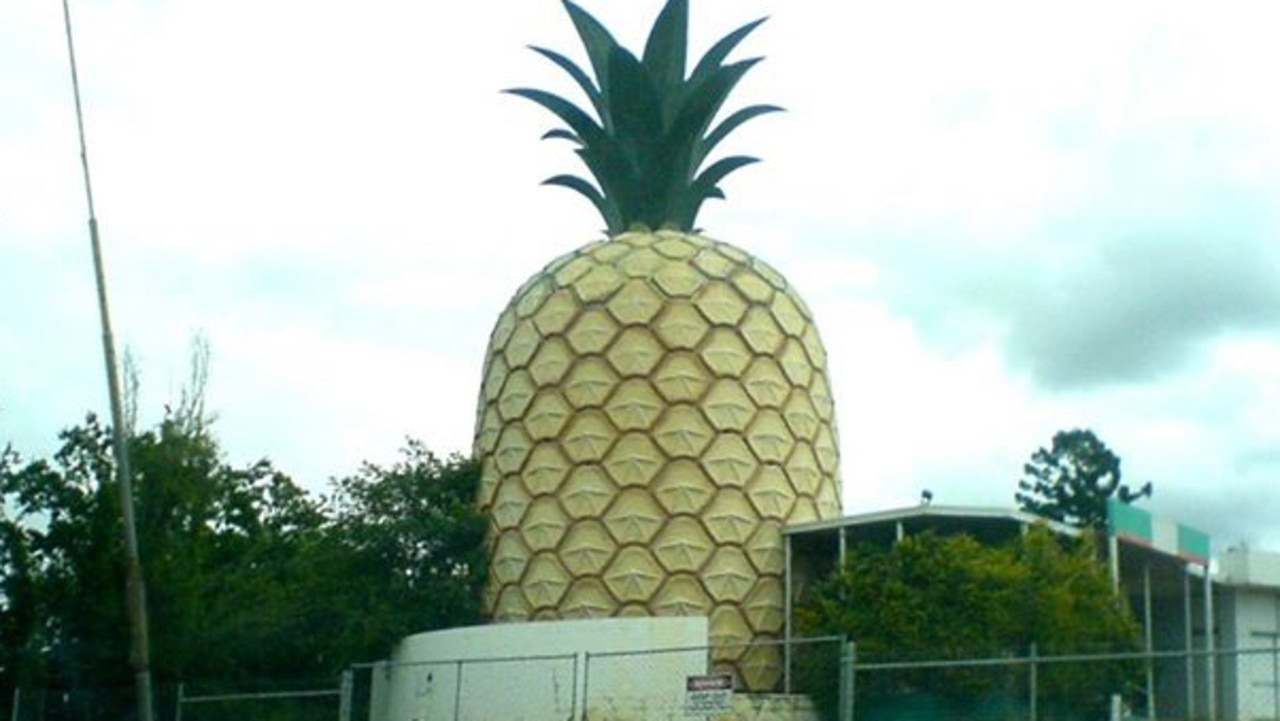
MORE: Where Aus richest built property empires exposed
During the glory days of the 1970s and 80s, the Big Pineapple boldly claimed to host more than one million visitors a year and crowned itself Australia’s No 1 tourist attraction.
It’s now undergoing a mammoth makeover, which promises to see the launch of a new cafe, new children’s playground, new viewing platform, a pineapple plantation, and a fully restored train.
The renovation project has been undertaken by owner Peter Kendall and his company CMC Property, who bought the Big Pineapple in 2011 for $5.8 million. It had previously been owned by the same family for three decades.

Generations of Aussies will remember the Big Pineapple for road trips to the sunshine state, birthday parties and weddings, train rides and ice-cream.
It may also be remembered for the time a local man took the famous train for a joy-ride before crashing it and derailing four of its carriages in 2020. No one was injured.
THE BIG MANGO – BOWEN
The Big Mango stands at the tourist information centre in Bowen.
According to Tourism Bowen, the Big Mango was erected in 2002 as part of a community campaign.
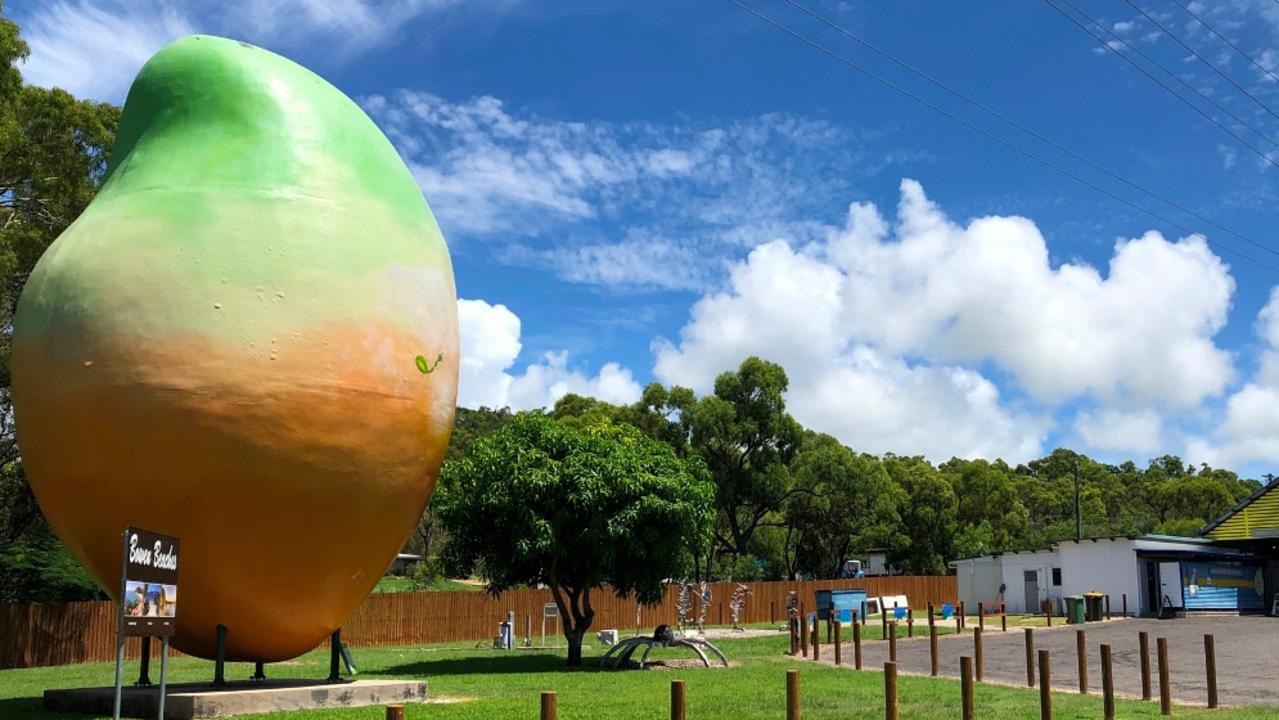
MORE: Nick Kyrgios’ lover strips off for record deal
The 10m-high sculpture made headlines in 2014 when it mysteriously disappeared overnight.
It was later revealed that restaurant chain Nando’s was responsible for the heist as part of a stunt to promote a new mango and lime-flavoured sauce.
As a sign of appreciation to community support, Nando’s later donated the Big Mango’s doppelganger, the Mini Mango to Bowen.
The Mini Mango is a 6m-high mango that was constructed to appear as the Big Mango in Melbourne as the actual $90,000 Big Mango was too big to make the trip.
The Mini Mango is located on Bowen’s foreshore.
THE BIG KANGAROO – KYBONG
Brisbane’s big Kangaroo isn’t just another one of Australia’s larger-than-life icons — her name is Matilda, and she has a 30-year history that’s taken her all around Queensland.
Built on top of a forklift for the city’s 1982 Commonwealth Games, Matilda was a 13m tall animatronic that could move its head, ears and eyes. She was seen winking at the audience during the opening ceremony of the games, with children running out beneath her pouch to enter the field.
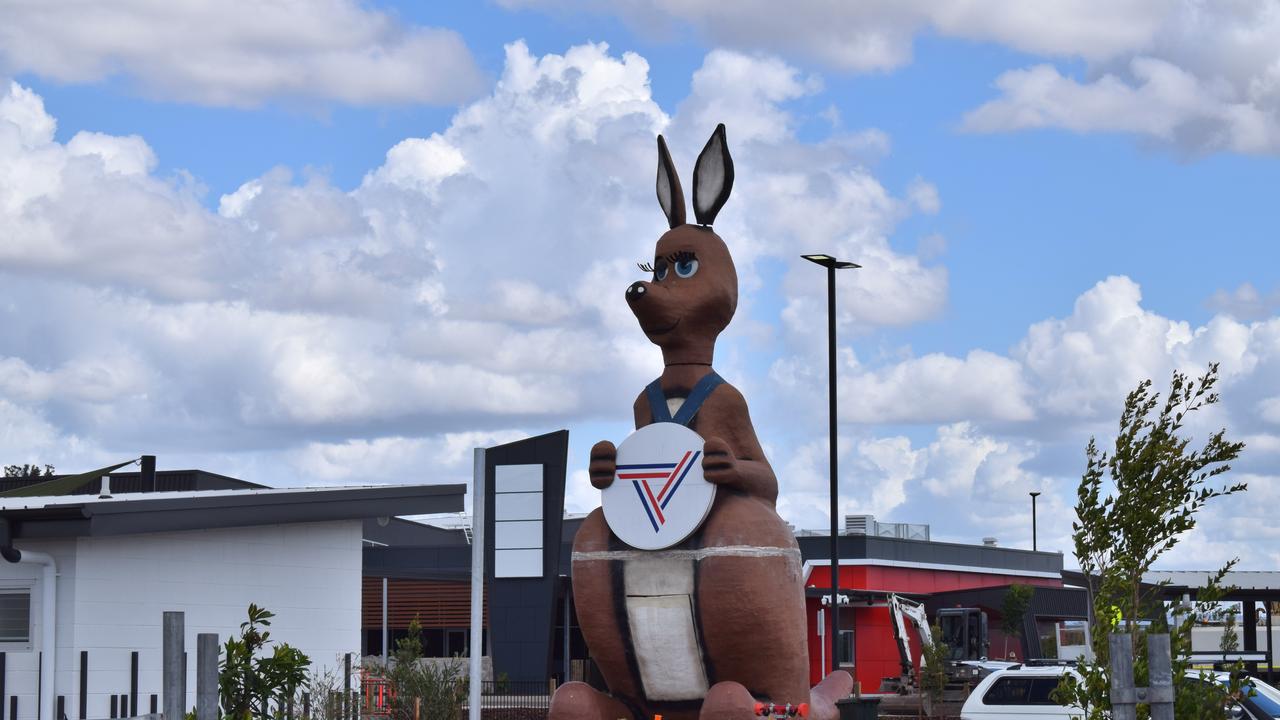
After her service, she travelled south to sit by the entrance to Cade’s County Waterpark, which would eventually become Wet’n’Wild Gold Coast.
When Puma Energy bought Matilda in 2009, it required extensive repairs, with tens of thousands of dollars placed helping the kangaroo stand the test of time.
Puma’s services were eventually replaced by Caltex, and now Matilda sits north of Brisbane, at a rest stop right next to Caltex Traveston in Kybong.
She’s still getting visitors to this day, and is still able to wink and turn her head. She’ll be turning 50 in 2032 — the same year as the Olympic Games in Brisbane, and officials are hopeful she can make an appearance.
THE BIG CROCODILE KRYS – NORMANTON
Krys the Croc is a life-size replica of the largest saltwater crocodile ever caught, measuring a mind-blowing 8.64m.
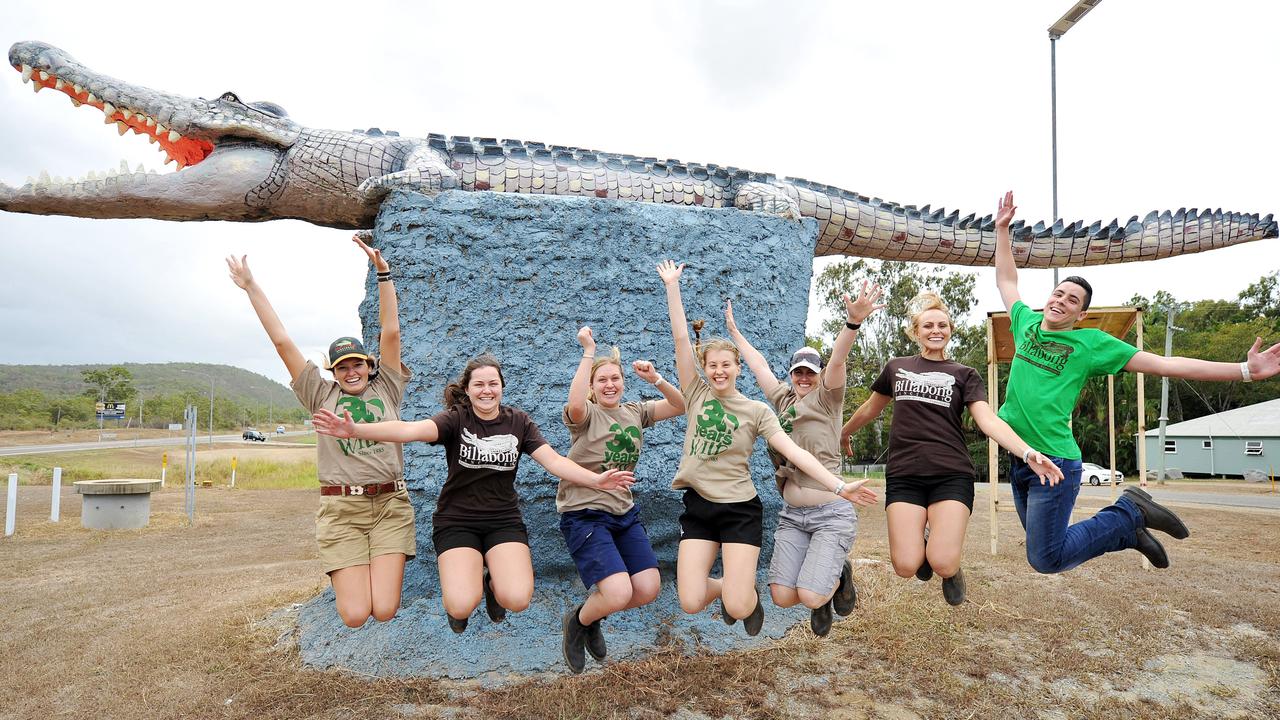
The monster croc was shot on the banks of the Norman River in 1957 by Krystina Pawlowski.
Normanton is also home to the Big Barramundi which was constructed in 1995 and measures 6m long. The giant croc replica is maintained by the Carpentaria Shire Council.
THE BIG BULLS – ROCKHAMPTON
Six bull statues are located across Australia’s beef capital, Rockhampton.
The first two bulls, a Bradford Bull and a Brahman Bull, were erected in 1978, on the Bruce Highway and on the median strip near the Red Hill Homemaker Centre respectively.
A Santa Gertrudis Bull was erected in Frank Ford Park in 1985.
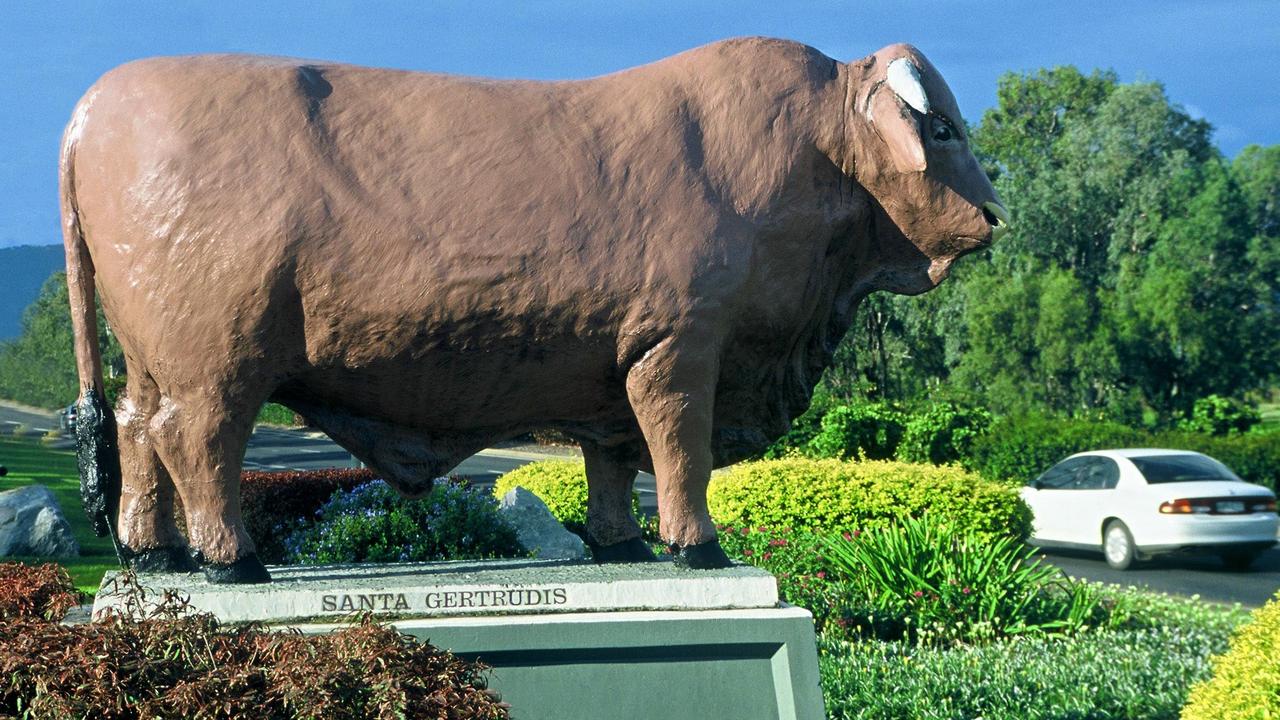
In 1994 a Droughtmaster Bull was erected at the entrance to the airport, while a Romangnola Bull, located in O’Shannesy Park, was erected in 1997 to commemorate the Italian Beef Cattle World Congress.
The final giant bull, another Brahman, was erected in 2000 at the roundabout on the southern entrance to the city.
But there are plenty more life-size bull statues throughout the regional town.
“These quirky statues are part of the triennial Beef Australia Expo, which has become an iconic event for the Australian beef industry and a major event for the state of Queensland,” according to Tourism Queensland.
They are maintained by the Capricornia Regional Council, which even employs someone to make replacement concrete bull balls. Turns out, pranksters sometimes castrate the concrete cojones.
THE BIG CANE TOAD – SARINA
Buffy the cane toad is owned by Mackay Regional Council and is maintained by council’s Parks and Open Spaces team.
Located in the town centre of Sarina, about 35km south of Mackay, locals nicknamed the landmark Buffy after the cane toad’s scientific name, Bufo Marinus.
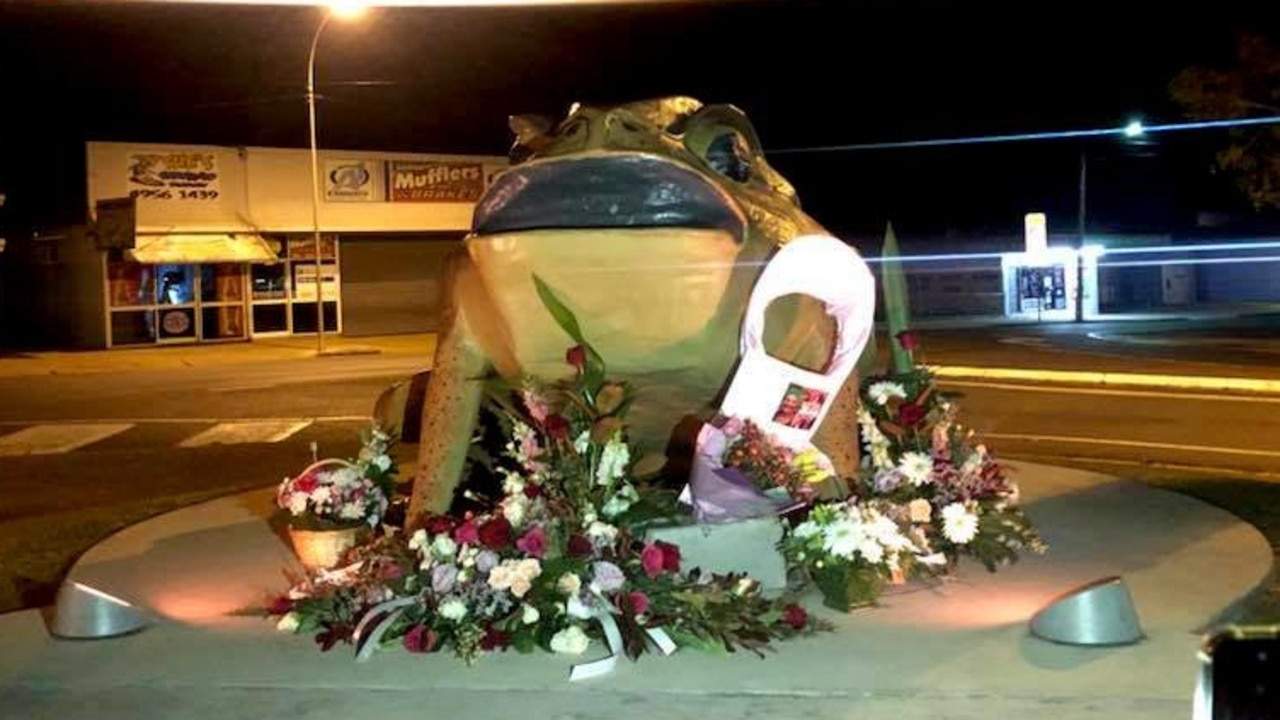
He was the brainchild of a former Sarina Shire councillor, the late Jean Coleman, who ran the Tramway Motel on Sarina’s northern outskirts with her husband Bevan.
Friends who knew them said motel guests were always amazed by the size and number of cane toads sitting around the street lights.
So, Bevan and Jean decided to make a giant paper maché toad, which featured on floats in Sarina’s annual Apex Sugar Festival and Mardi Gras parades in the 1970s and 80s.
Buffy was such a hit with the locals that he was cast in fibreglass and placed in the main street.
In 2016, he was given a fresh lick of paint and skipped up onto a platform, while council added a plaque celebrating four other famous Sarina exports — rugby league superstars Dale Shearer, Kevin Campion, Martin Bella and Wendell Sailor.
Daly Cherry-Evans, Reuban Cotter and Brianna Clark were added in 2023.
THE GOLDEN GUMBOOT – TULLY
The Golden Gumboot is a competition between the Far North Queensland towns of Tully, Innisfail, and Babinda for the wettest town of Australia.
It opened to visitors in Tully in 2003, and was inspired by a gumboot trophy awarded to the wettest town annually since 1970.
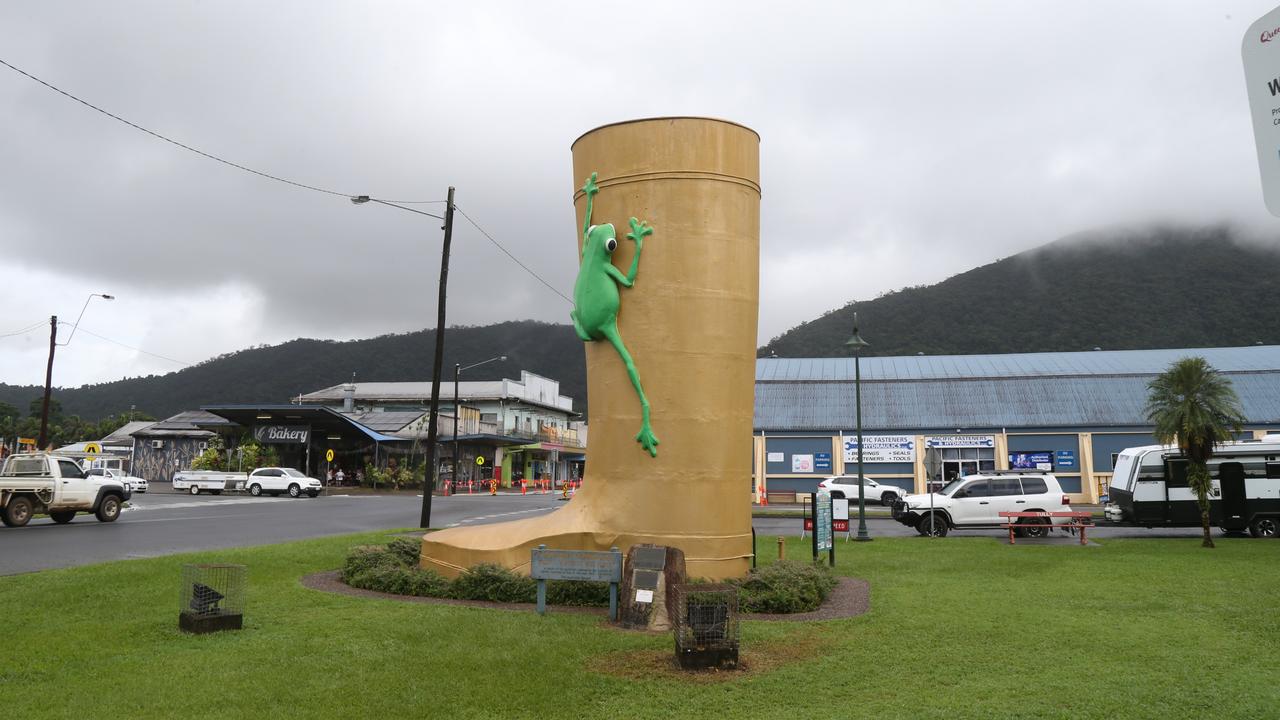
The giant gumboot with its carved white-lipped green tree frog was built in nearby Millaa Millaa.
It is located in Tully’s Banyan Park, which is maintained by the Cassowary Coast Regional Council.
The Golden Gumboot was erected by the Tully Lions and Rotary clubs and is nearly 8m high.
In 2023, Whyanbeel Valley in the Daintree took out top spot as Queensland’s wettest overall location with a whopping 5187mm, which was mostly due to a record flood event in the wake of Cyclone Jasper.
SOUTH AUSTRALIA
THE BIG SCOTSMAN – MEDINDIE
Every big novelty statue created in Australia is said to have followed this 5m-high Scotsman, known as Scotty, which was erected in 1963 at a motel on a corner at Adelaide inner suburb of Medindie. This was a full year before Coffs Harbour in NSW welcomed big banana, the other claimant to be first.
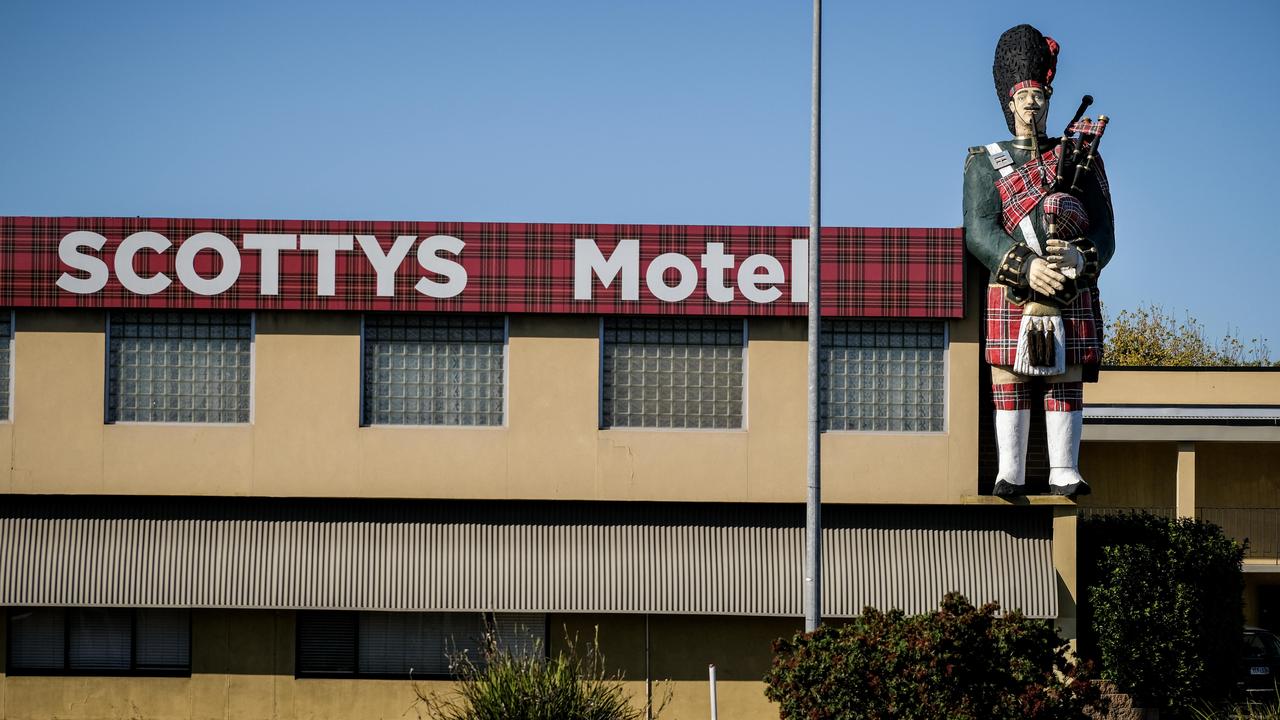
Created by Paul Kelly, who went on to build Larry the Lobster in Kingston, Scotty is the centrepiece of Scotty’s Motel on 1 Nottage Tce, which last passed hands in 2022 for an impressive $9.2m
THE BIG LOBSTER – KINGSTON SE
The Big Lobster, affectionately known as ‘Larry’, was born in 1979 after being designed and built by the creator of The Paul Kelly.
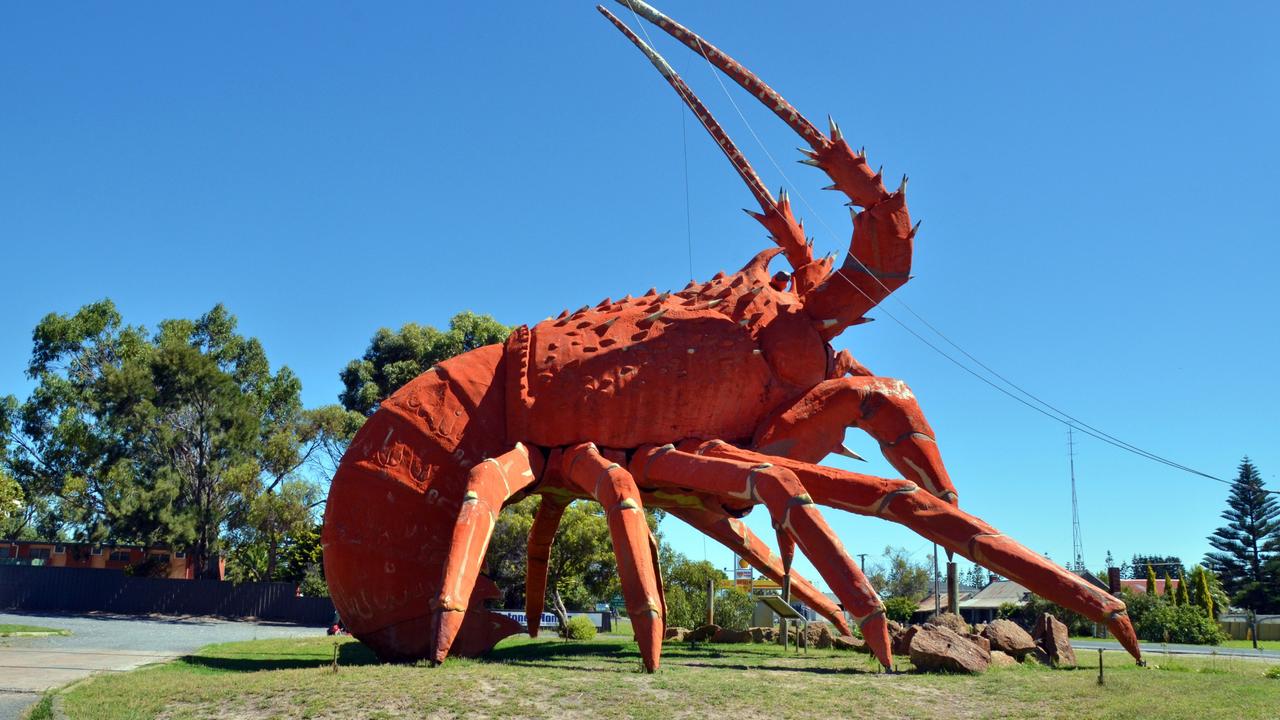
The 17m tall statue was originally conceived by Ian Backler, a local lobster fisherman, who formulated a plan to build a visitor centre in Kingston while travelling in the United States.
The statue made national headlines in 2018 when, in an eleventh-hour bid, a South Aussie pastoralist family saved Kingston’s famous giant crustacean from moving interstate.
The statue underwent a $50,000-plus makeover before being put on the market and, along with an attached restaurant and 4200sq m piece of land, was advertised for sale for $300,000.
THE BIG ORANGE – BERRI
Measuring 15m in height and 12m wide, The Big Orange is considered the biggest of the ‘Big Fruits’ in Australia.
Located on the outskirts of Berri, Riverland SA, The Big Orange was conceived by Bronte Coombe, Vern Chubb and David Marshall who invested $145,000 into the venture in the mid-1970s, which also included a cafe, souvenir shop, function room, lookout and a 360 degree mural within the structure.
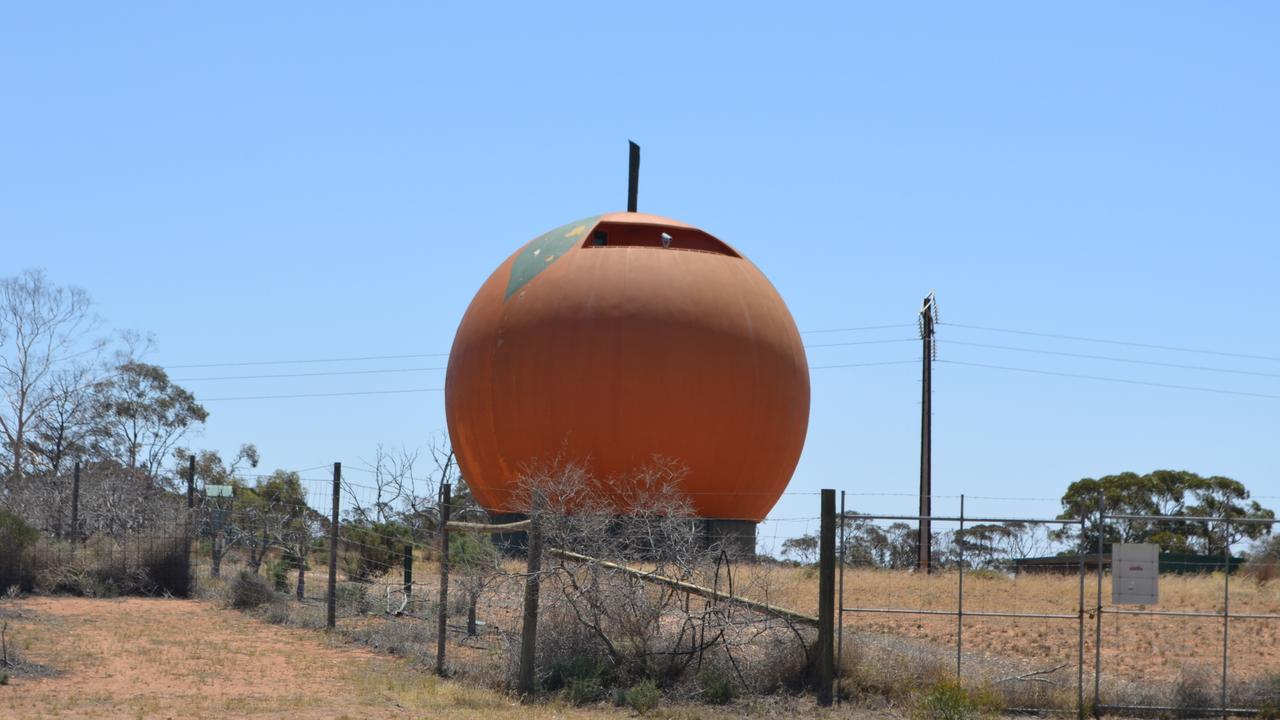
It was sold in 2002 for between $100,000 and $120,000 to RivSkills, which operated the attraction as an Enterprise Learning Centre, but were forced to close the site two years later, with the owners citing “financial losses and management issues” as contributing factors.
The site is now owned by Fred Vallelonga who, only last year, lodged plans for a $1.5m project to develop the landmark into a distillery, brew house and restaurant — marking an end to two decades of inactivity.
THE BIG ROCKING HORSE – GUMERACHA
One of the Adelaide Hills best loved attractions, this Gumeracha icon at 452 Torrens Valley Rd, Gumeracha welcomes visitors to a toy shop, wildlife park, cafe and now a brand new mini golf course.
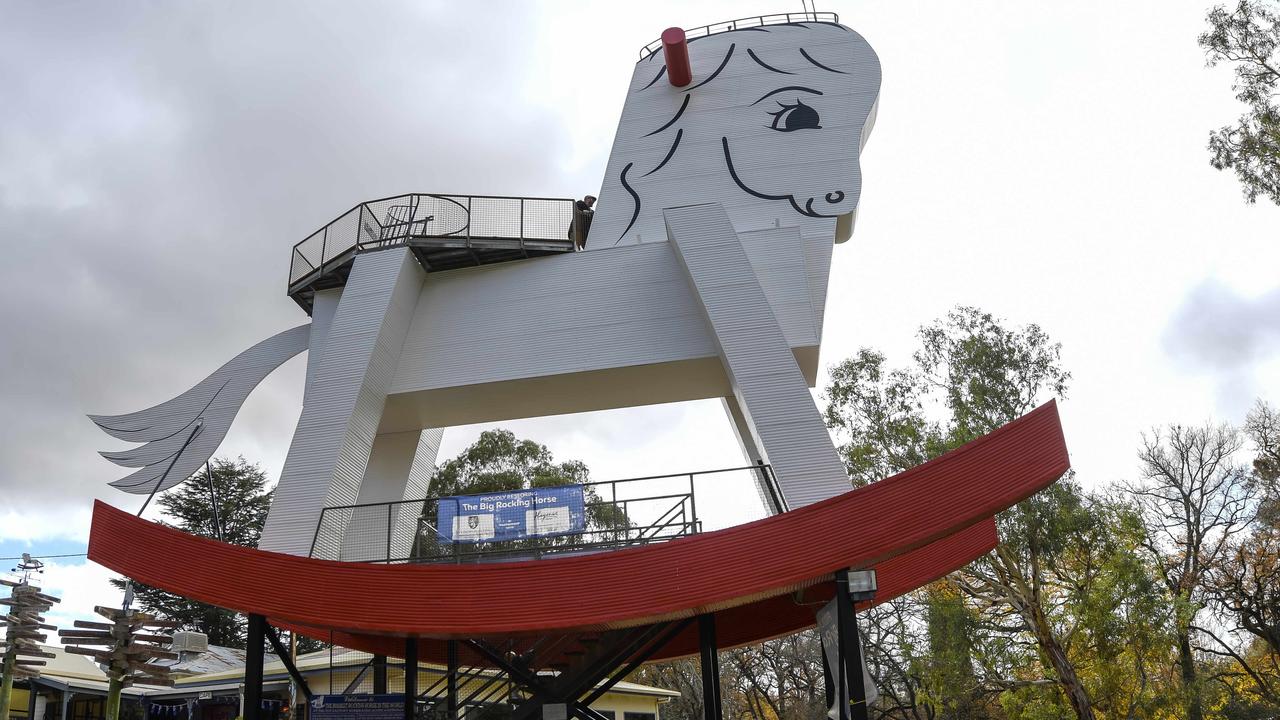
Designed by David McIntosh and opened in 1981 after an eight-month construction, the structure, which cost $100,000 to build stands 18.3m tall and, via a series of internal ladders and walkways, tourists are able to climb to the lookout on top of its head.
According to the attraction’s website: “In September, 2003, Graeme Wilkinson placed the Toy Factory — including the Big Rocking Horse — on the market, at an asking price of approximately $900,000.
It was sold in 2004 to Anthony Miller, who had emigrated from South Africa in 1999. Under Miller the structure was restored and reopened to the public, with visitor access to the viewing platforms available from April, 2004.
Changes made by Miller, including the reopening of the Big Rocking Horse and the removal of entrance fees to the associated wildlife park, saw an overall increase in visitor numbers to the complex from 65,000 in 2003 to 200,000 in 2006. In June 2009 the business was purchased by Frans and Lyn Gous, another family of business migrants from South Africa, and continues to go from strength to strength.”
THE BIG GALAH – KIMBA
Drive exactly halfway across Australia from east to west, or west to east, (whichever you fancy) and you’ll come across Kimba. In doing so, you’ll inevitably see the Big Galah. Why? Well, at 8m tall, you can’t miss it. Especially not since it’s been given a vivid facelift.

The pink and grey bird sits in front of the Halfway Across Australia Gem Shop on the Eyre Highway, welcoming visitors to the rural town and has been the sight of many a selfie since it was built in 1993.
Built by Roger and Dianne Venning as a way of luring travellers to their gem shop, the galah took 18 months to build, using help from their four children during the school holidays.
With the help of funding from the National Radioactive Waste Management Facility Project and the Community Benefit program, the big galah in 2021 got a facelift courtesy of two artists, Karen Carr and Jill Pantiyasa, who brought it back to life through the use of 32 different pink and grey colourings.
MAP THE MINER – KAPUNDA
Sitting on the edge of the road at Kapunda, this statue pays tribute to the Cornish mining history of the town, and the big fella is also known as Map Kernow or the Son of Cornwall.

Sitting on the edge of the road to greet visitors to the town, the 7m giant was designed by a Dutch artist, Ben van Zetten, living in a nearby town in 1986 and constructed of fibreglass, with the icon taking three months to build.
The statue was destroyed in 2006 when a local teenager poured eranol around the statue, intending to take a photo of the attraction in a ring of fire. Unfortunately he splashed some of it onto Map’s right leg, and he caught alight, causing $95,000 worth of damage. Thankfully he was insured for $140,000 and the original artist was brought in to rebuild the statue – this time from bronze.
THE BIG SANTA – ADEAIDE
One of Adelaide’s best loved Big Things is also one of its most temporary. Adelaide’s 16m Big Santa was built in the 1960s and hung off the side of the then John Martin’s and later David Jones in Rundle Mall.
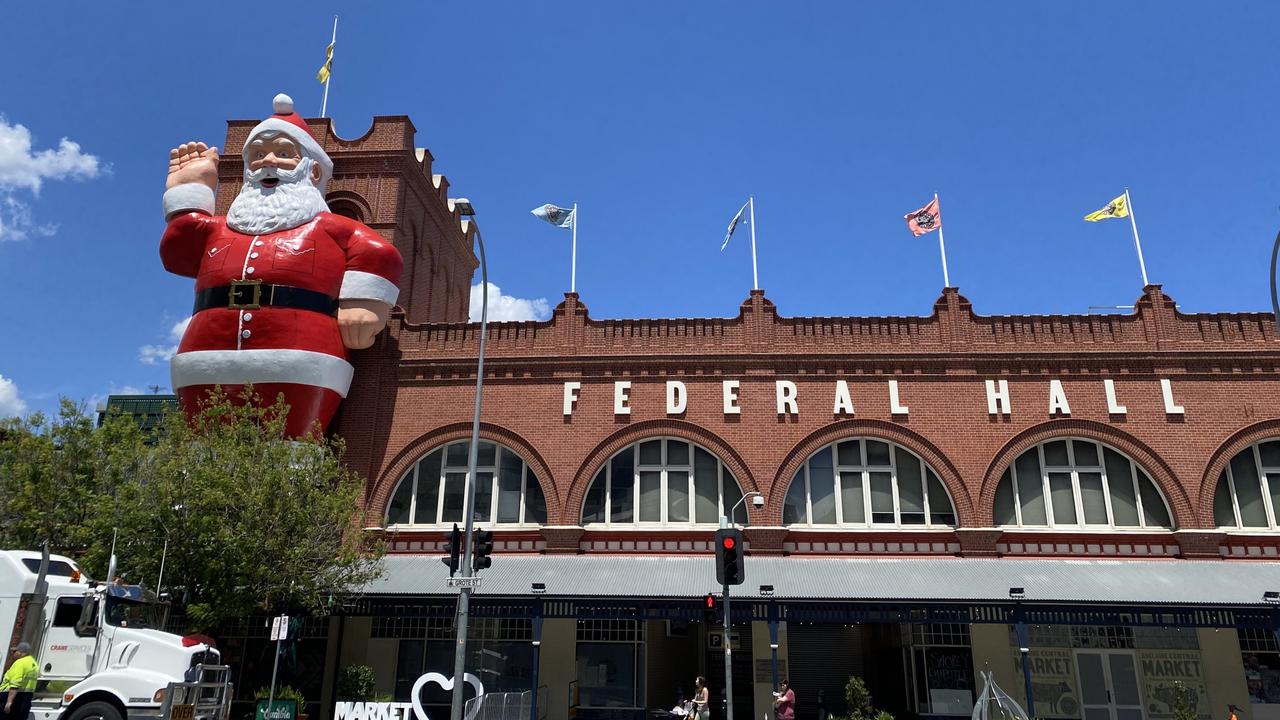
Retired in 2018, the 15m-high fibreglass, wooden and metal figure was degrading in a shed at Kilburn facing an one-way trip to landfill when he was saved by media personality Andrew “Cosi” Costello, who bought him from the Adelaide City Council for just $2.
After being fully refurbished using donated labour, materials and a $45,000 donation from Adelaide identity Lance Vater, he now stands proudly on the side of the heritage-listed Federal Hall at the Adelaide Central Market each Christmas.
THE BIG PELICAN – LOXTON

The Big Pelican was built of paper mache in 1979 as a float in the Loxton Mardi Gras. It made several appearances at similar events across different towns and cities across Australia in the subsequent years, and was remodelled and coated in fibreglass in 1992 and now takes pride of place near the Loxton Riverfront Caravan Park.
VICTORIA
THE BIG PHEASANT, BRUNO
Many of Victoria’s mighty monoliths are owned by small businesses or municipal councils, whereas a few have more prominent proprietors – such as Bruno the Big Pheasant at West Gippsland’s Gumbuya World Theme Park.
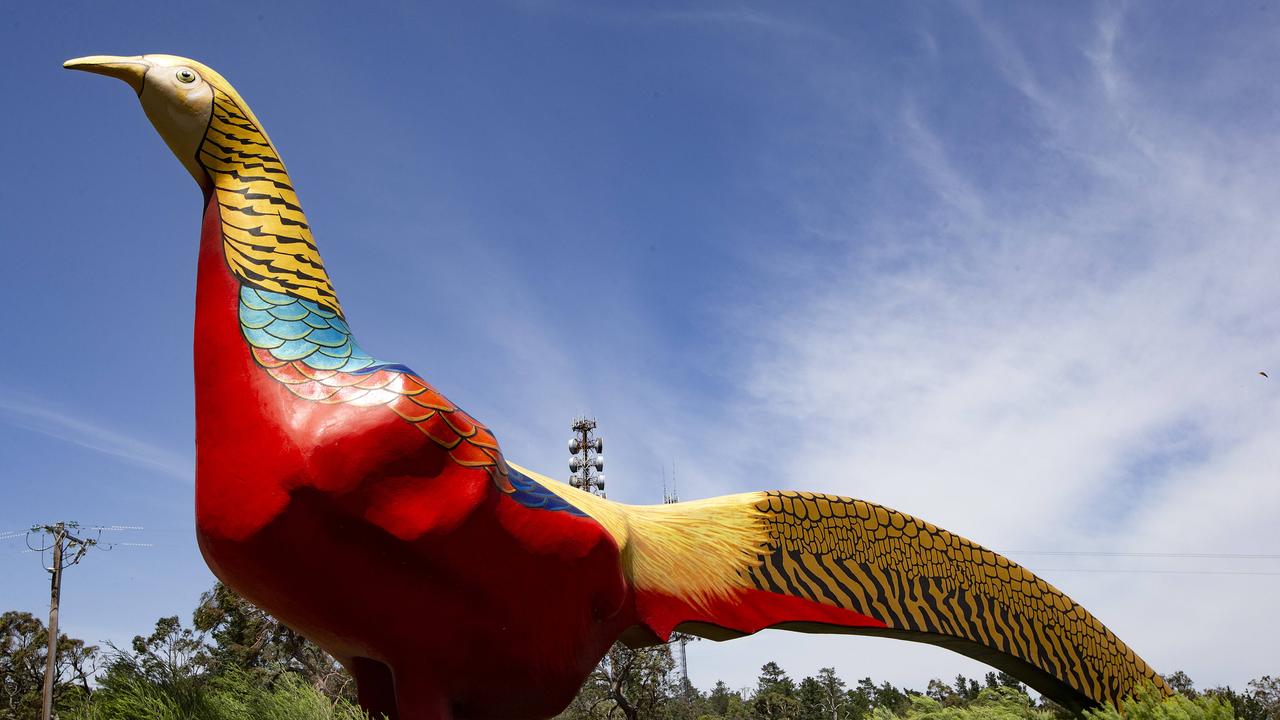
A consortium including Jayco Caravans’ founder Gerry Ryan, Carsales.com.au founder Wal Pisciotta, Car Megamart director Ray Weinzierl and Campbell Constructions’ directors Adam Campbell and Brett Murray acquired the site before giving it a $50m makeover in 2017.
Gumbuya’s wildlife manager Tony Hower, a long-time employee who has held several positions at the Tynong North amusement park including a stint managing the entire site, remembers when the 7.6m-tall Bruno statue’s “bum got blown out of him” and caused more than $50,000 worth of damage.
In 2011, two people allegedly broke in and set off the bomb. Police arrested a man at the time who was later released.
The idea for the sizeable sculpture, representing a golden pheasant, came about because the amusement park started life as a pheasant farm.
Gumbuya founder and former owner Ron Rado commissioned the concrete and steel bird’s creator Bruno Crestani, after whom the bird is named, to bring it to life in 1981.
THE BIG SPHINX
The owner and general manager of North Geelong’s The Sphinx Hotel, George Ramia, said the Great Sphinx of Giza’s polystyrene copy atop his business’ roof was built in the 1990s with the aim of attracting more visitors.

He initially asked about five different architects for Sphinx-related concepts and settled on a Queensland firm that had previously worked for Dreamworld.
The 12-month construction process cost about $1.5m and involved painters and sculptors, with the completed Sphinx brought down from Queensland.
The Sphinx Hotel has been previously been on the market with price expectations in the vicinity of $40m or $20m for a 60-year lease of the business.
THE BIG NED KELLY
A famous historic figure immortalised in mega-size is bushranger Ned Kelly with statues in Maryborough, Queensland, and at a mini golf course near Ballarat.
But arguably the most famous incarnation is a 1.5 tonne, 6m-tall statue in the Victorian town of Glenrowan, where Kelly lived as a youngster before his infamous last siege took place at a local inn in 1880.

Named after Kelly’s sister Kate, Kate’s Cottage, Gifts & Souvenirs including the Ned Kelly Museum is located opposite the Big Ned.
Now run by Michelle Coad and husband Douglas Stoneman, their predecessors Chris and Rod Gerrett commissioned a Sydney special effects technician to create the statue for approximately $14,000 in 1992.
“It was effectively a donation to the town,” Ms Coad said.
While Big Ned doesn’t technically have an owner, a now-disbanded community group previously repainted the statue and a body corporation of nearby businesses cares for the nearby gardens.
THE GIANT KOALA
Many of Victoria’s big things are animals, including the 14m-tall Giant Koala souvenir shop and cafe in Dadswells Bridge at the foot of the Grampians.
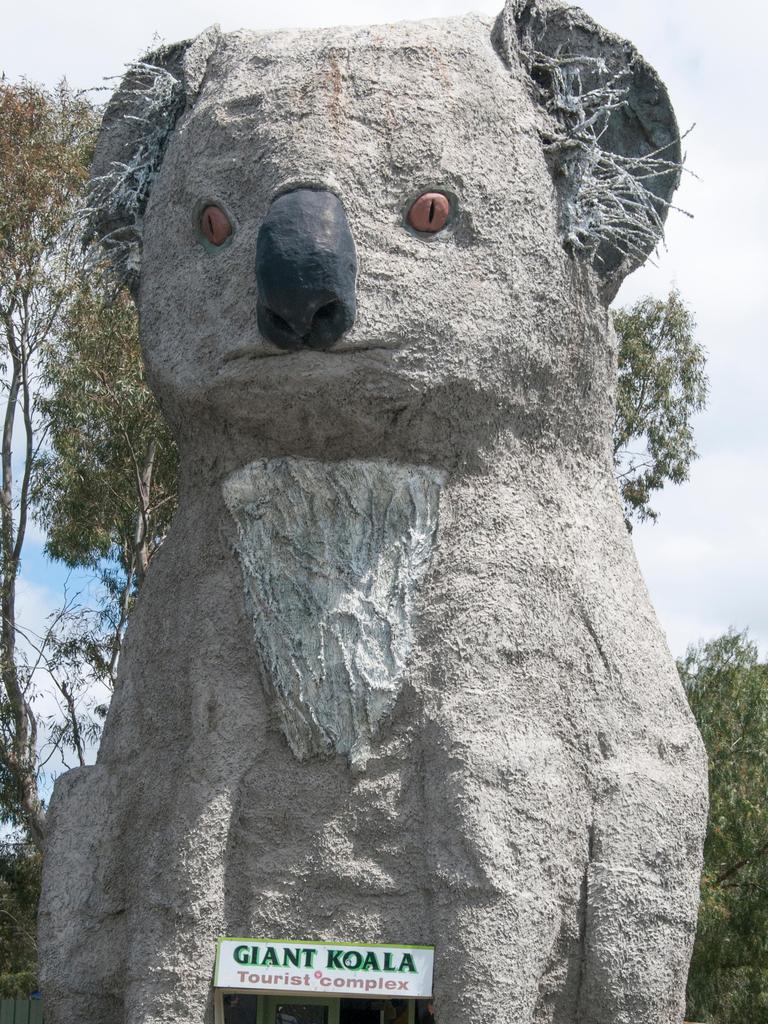
Dreamt up by former motor inn and roadhouse operators Beryl and Jim Cowling in the 1980s, the bronze, fibreglass and steel structure was made by sculptor Ben Van Zetton.
Public records show the business sold for $220,000 in 2014. It is now run by owner Pat Crute.
THE GIANT GNOME
Langwarrin’s McClelland Sculpture Park and Gallery is home to more than 100 sculptural works, some of them quite large.
A famous inhabitant is a 10m-high stainless steel gnome by sculptor Gregor Kregar officially named Reflective Lullaby and dubbed Frankie by locals.

The gallery’s artistic and executive director, Lisa Byrne, said Frankie was made under a sculpture commission program funded by the Peninsula Link Freeway builder Southern Way.
It sees sculptures commissioned for two sites along the freeway, to be alternated every few years before becoming part of McClelland’s permanent collection.
Ms Byrne said Frankie was moved to the park a year ago. She noted the $300,000 commission to create Frankie was mainly spent on production and planning approvals, with a minimal artists’ fee.
NEW SOUTH WALES
THE BIG BOGAN – NYNGAN
Extending a friendly welcome to the country town of Nyngan, the 5.96m-tall Big Bogan – with his thongs, fishing rod, Esky and Southern Cross tattoo – references the town’s warm hospitality and serene Bogan Shire and Bogan River.
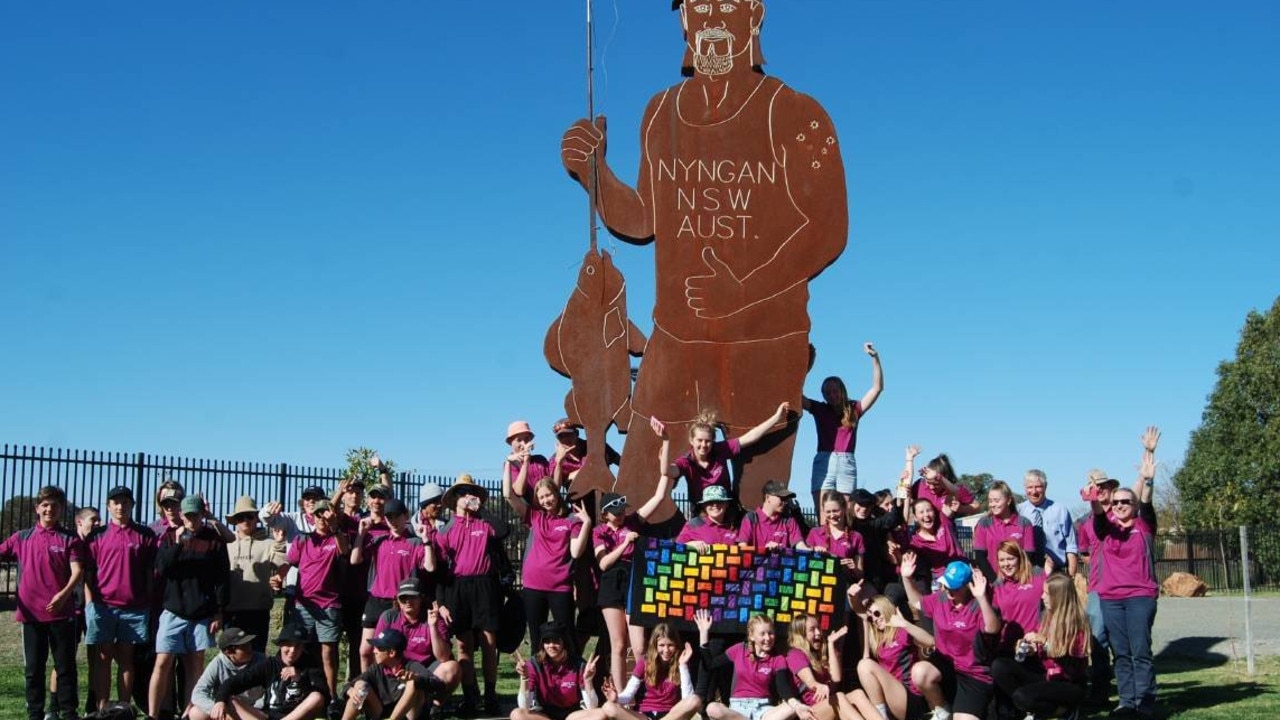
The Big Bogan was commissioned by the local council in 2015, after the town’s engineering manager proposed the idea, hoping to attract tourists to the small town of only 2000, who were often spotted snapping pictures next to the Bogan signs around town.
Reports at the time say locals were “divided” over the plans of a large statue of a bloke in shorts, worried the town would gain a reputation for “cultivating idiots.”
Created using large sheets of steel, the image of the ‘bogan’ was drawn using a computer design software. The fishing rod was added with a combination of flat steel, pipe and stainless steel cable.
THE BIG UGG BOOTS – HUNTER
Located in the Hunter Region is the home of the Mortels Sheepskin factory and along with it, The Big UGG Boots which are 13 times the size of a women’s size 8 UGG boot.
Erected in April 2015, the boots have been known to withstand some of the Hunter Regions most catastrophic weather events, including a storm that was the equivalent of a category 2 Cyclone the day after it was erected.
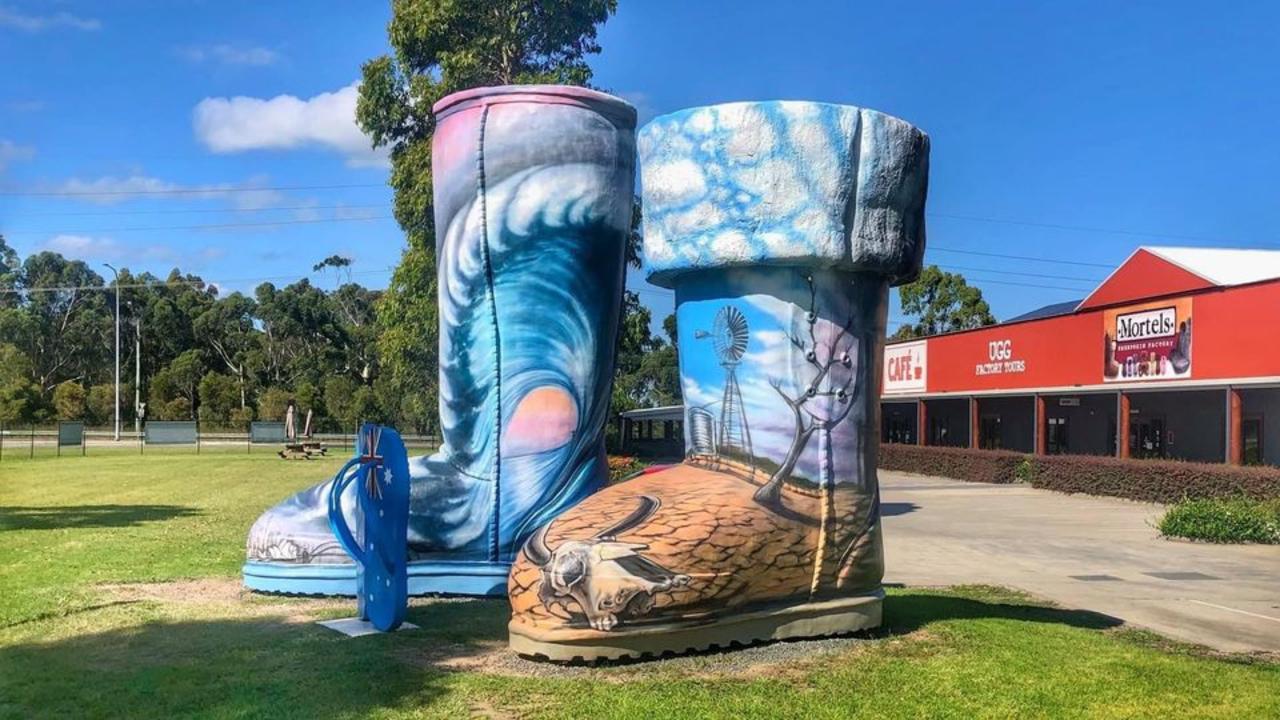
The Big UGG Boots, constructed with fibreglass and steel, weighing approximately 600 kgs each, have stayed strong throughout the rains and heavy winds.
Every two years, the statue gets repainted, sometimes a combination of colours and other times artworks, each design conveying a theme.
The current theme is “Mother Nature’s Final Say,” depicting Australia’s weather events and effects on the landscape.
THE BIG BUSH TURKEY – KYOGLE
Creating The Big Bush Turkey was a long-held aspiration for Kyogle couple John and Chrystine Graham. At four metres high and 8.5m wide, it’s hard to miss The Big Bush Turkey as you drive from Casino to Kyogle on Summerland Way.
Built from concrete, the hefty bush turkey had to be created on site due to its 16 tonnes weight.
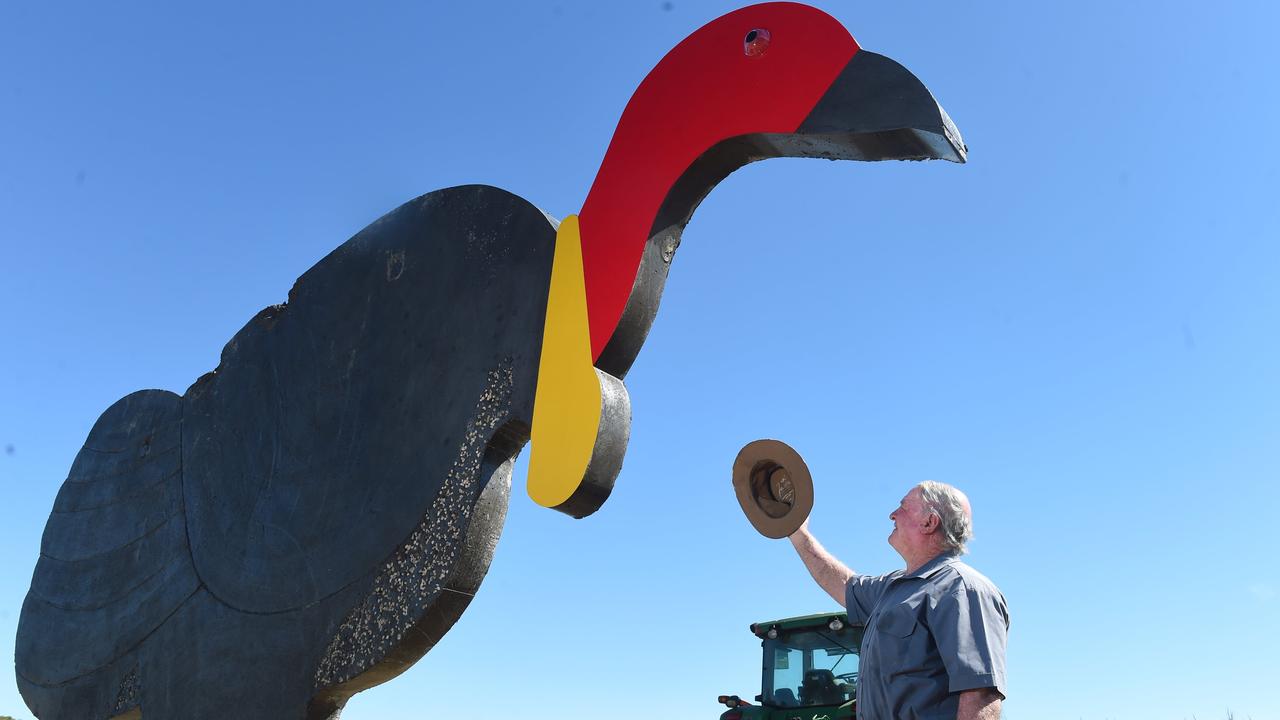
Mr Graham told NewsCorp in 2018 that he hoped to build a big bush turkey after caravanning seeing other towns with their ‘big things’.
Having lived in Kyogle for 66 years, he said he’d always been fond of the bush turkeys and had spent a lot of time around them.
“I also did it because the name Kyogle means bush turkey in Aboriginal … that’s why we are called the turkey town,” he said.
Having the help of his sons, who now owned his concreting business, Mr Graham paid for the Big Bush Turkey all it took to create The Big Bush Turkey all out of his own pocket.
THE BIG HAT
The Big Hat was modelled off famous Australian bush poet Banjo Patterson’s iconic Akubra hat.
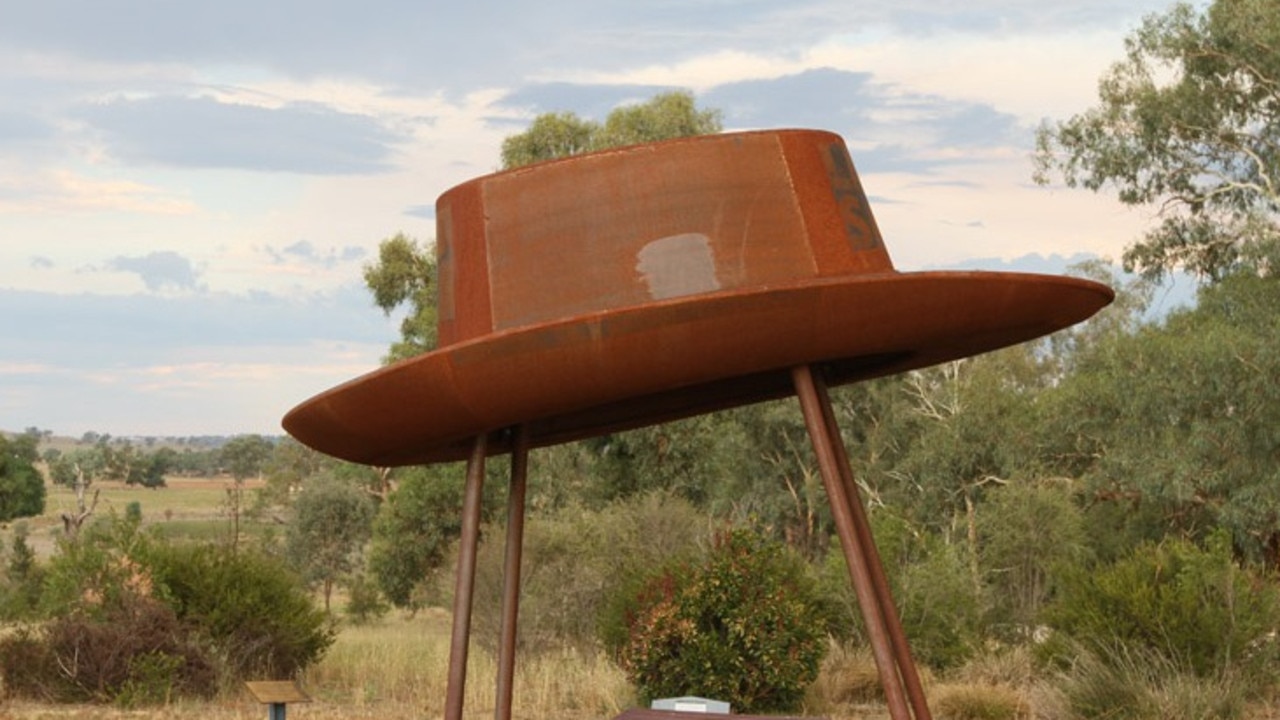
Located in the Banjo Paterson Bush Park and across the road from the Banjo Paterson More Than a Poet Museum in Yeoval, a quiet rural service centre, famous for its association with Banjo Patterson where he lived for the first seven years of his life.
Tourists can stop and enjoy the shade at the picnic table under The Big Hat, which stands as one of the largest bronze statues in Australia.
THE BIG TENNIS RACQUET
This large Dunlop racquet is a scale model of tennis star Evonne Goolagong-Cawley’s battered wooden racquet with her signature on the handle.
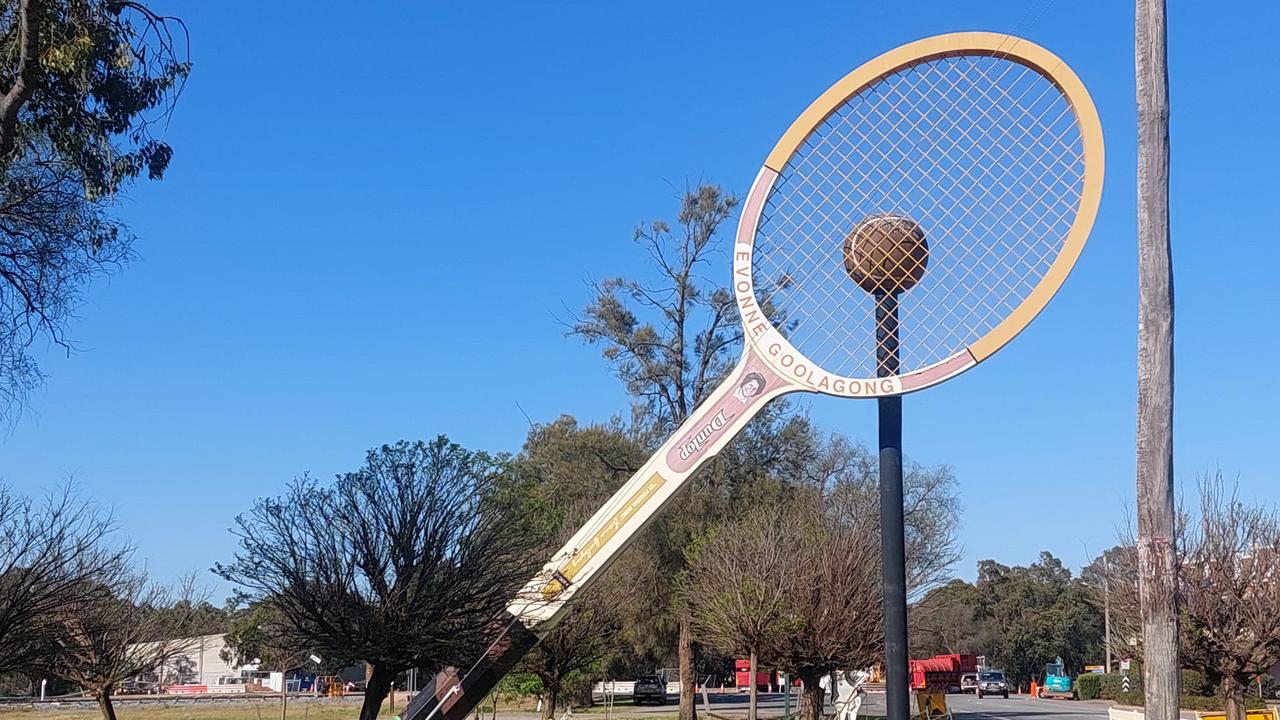
Created to celebrate the 100th year of the town Barellan and its proud association with Evonne Goolagong-Cawley MBE AO who is a Wiradjuri woman who was born in the Riverina and grew up in Barellan.
Local Barellan farmer, David Irvin was the driving force behind the construction of The Big Tennis that stands 13.8 metres tall on Barellan’s main street.
Originally published as Shock amount Australia’s weirdest Big Things are worth

